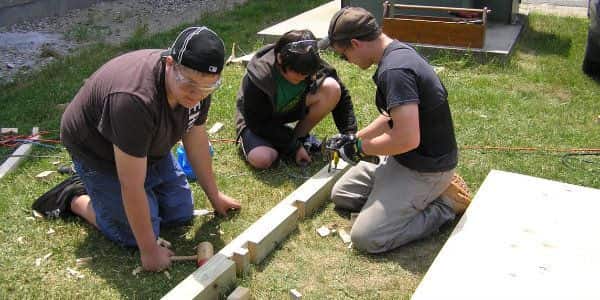When a storm destroyed the greenhouse at Buckfield Junior-Senior High, teachers and students knew they must build something stronger for their garden program to survive Maine’s harsh, long winters.
Led by High School Science Teacher Caleb McNaughton, a team of 11th and 12th grade science and technology students devoted half a school year to designing and constructing a 12-foot x 24-foot modern greenhouse, funded by a Whole Kids Foundation grant.
Besides extending the growing season, the greenhouse project also accomplished many other goals. It created stronger links between the garden and classroom curriculum across many subject areas and extended the reach of the garden program to the high school level (it was previously focused on younger grades). The new, larger greenhouse also provides more opportunities for hands-on learning and a perfect space for students to start seedlings and conduct research and experiments.
For the kids, building a greenhouse was fun, challenging, hands-on work and an exciting change of pace that let them get outside, get active and “get real” with academic subjects.
“The students did all the work,” Caleb explains. “After a lot of research and planning, they decided a partially insulated greenhouse was the way to go. They determined the optimal angle for the roof pitch to handle snow load and allow light transmission. The kids chose the materials, made the tool list, made a budget, surveyed the land to make sure the school building didn’t cast too much shadow, created blueprint drawings to scale, submitted building permits to the town. They did all the measuring and fastening using screws, lags and nails. The only thing students didn’t do was the cutting for safety reasons.”
Also, each student was required to document individual work at every phase and create a computer slide show, which was presented at the end of the semester for a grade.
“When our students work in the garden, they are still working toward academic objectives and learning the same things they would have learned sitting at their desks. We’re just doing it in a different fashion,” Caleb says.
Teachers at Buckfield also noticed the greenhouse project helped many unmotivated students get back on track to meet district-required academic targets.
Integrating outdoor and indoor learning can mean extra work for teachers initially, as they develop non-traditional lesson plans. It also may require more collaboration across subject areas to ensure everyone’s goals are being met—but when it’s done well the rewards are rich.
“Building this greenhouse was an eye-opener for a lot of students to see how much math, science, writing and language arts all go into any project,” Caleb explains. “It really proved to them they need all of these skills. There’s a way to involve almost every student with any interest and make garden projects relevant.”
These older students also learned how it feels to leave behind something permanent that will be enjoyed by more kids for years to come. Their greenhouse is at the center of the school’s expanding garden program, which now also includes an outdoor classroom, a spring pig-raising program, and soon-to-be-completed “sugar house” (also designed and built by high school students) for making maple syrup.
“Our garden program is an opportunity to make learning real for students,” says Buckfield Junior High Math Teacher Annette Caldwell. “It’s a learning laboratory and it’s student-driven. The kids grow and build everything, and that’s why it’s successful.”
5 Tips for Greenhouse Greatness
- Seek out staff support. Building a greenhouse integrates so many skills and academic areas, it’s a project that can help school garden programs gain wider support from teachers and administrators. To make the most of it, everyone needs to be willing to invest a little extra time in planning lessons and collaborating.
- Keep project size manageable. Base your greenhouse plan on the number of students and budget, as well as site placement and size.
- Find successful examples in your area. Visit and talk with other schools and private businesses that utilize greenhouses to gain valuable tips, success stories, design ideas and maybe even donations.
- Lean on community experts. Find out if parents at your school can offer free student mentoring, consulting, materials or networking. Ask around to find architects, engineers or contractors.
- Build it into the school day, not after school. Devoting class time to the greenhouse (and any other garden project) ensures student participation and encourages stronger connections between the garden and the classroom.



